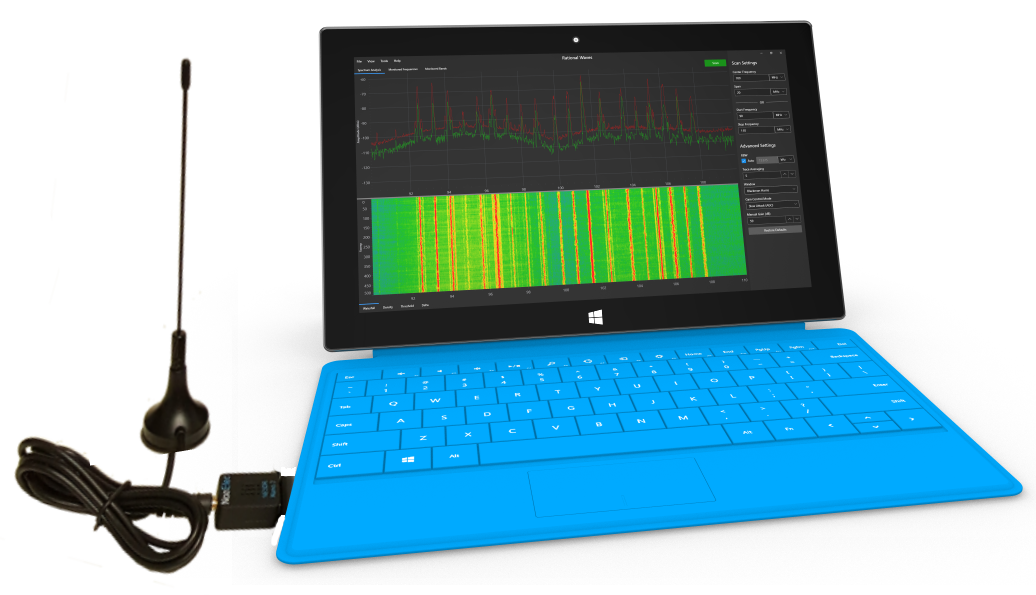SDR -- And Why Its Future Looks Bright
A software-defined radio (SDR) is a radio implemented with reconfigurable software, which processes the raw samples of a digitized radio signal. This contrasts with conventional hardware radios, which employ RF circuits and digital signal processors to implement this processing. Because much of the functionality is implemented in software running on a PC and not hardware circuitry, then SDRs typically cost much less. A software-defined radio still requires some hardware, but this hardware is relegated to just receiving and transmitting radio signals. An SDR system consists of a low-cost receiver and a host computer running software that performs data acquisition and analysis, along with a graphical display.
Why Rational Waves?
An inherent feature that often goes unheralded is Rational Waves' ability to bring wide-band, fine resolution spectrum scans to devices that are otherwise limited by bandwidth or number of data points per scan. RTLSDR devices are limited by small bandwidth (< 3 MHz). By "stitching together" many subscans the software can display wide band (up to 300 MHz) scans with fine resolution, allowing RTLSDR receivers to be used as near, real-time RF spectrum analyzers. This is the primary value the software brings to the table. In addtion, Rational Waves supports a variety of different RF analyzers and displays data using several types of graphical charts, which help reveal patterns or events in the spectrum data that might otherwise go unnoticed.

Basic Specifications
A SDR receiver is defined by three basic specifications: bandwidth, resolution, and tuning range. Bandwidth is the instantaneous width of frequency content that the SDR receiver can receive. It can be thought of as the width of the SDR’s window into the RF spectrum. Resolution refers to the receiver's ability to distinguish between adjacent signals. If the resolution is too course then adjacent peaks may appear as one. And tuning range is the frequency range that the SDR receiver can tune to -- which is very specific to the receiver's hardware. For example, an AM radio can not receive FM signals and vice-versa.
For RF spectrum analysis, all three specification are important. If bandwidth is too narrow, then you can't scan a wide frequency range such as UHF or Wi-Fi. And if resolution is too course then you can't tell whether a peak is a single transmitter or two adjacent ones. And the tuning range must match with the frequency range you wish to monitor. If you work in wireless pro audio and wish to monitor the UHF band (e.g. 470-608 MHz) then you'll need an SDR receiver with that capability.
Antennas
The most under-appreciated component of a wireless system is the antenna -- they are not all created equal. The frequency range supported by an antenna is *very* specific. If the frequency range of the antenna you are using does not match with your particular application then your project will fail. The good news is that antennas are relatively inexpenive -- only a few dollars -- so we recommend purchasing a few and testing which ones work best with your SDR system. Some vendors include wideband antennas (i.e. antennas that can receive a broad range of frequencies) with their SDR receivers that may be "good enough" for your particular application. But the burden is still on the user to ascertain the suitability of an antenna for the task at hand.
RTLSDR Receivers
Included among the RF analyzers supported by Rational Waves are SDR receivers based on the R820T2 tuner IC made by Rafael Micro and the RTL2832U demodulator and USB interface IC made by RealTek. RTLSDR receivers support a frequency range of 24 MHz up to 1766 MHz, which makes them ideal for use in a broad array of RF-related applications -- in particular, wireless pro audio, where frequency coordination and interference mitgation are critical.

Cost
Hard to believe -- RTLSDR receivers typically cost under $50 USD, and as low as $15 USD -- depending on the SDR's capability, internal components and accessories. For the best selection, prices, shipping options and after purchase support our favorite source is NooElec.

